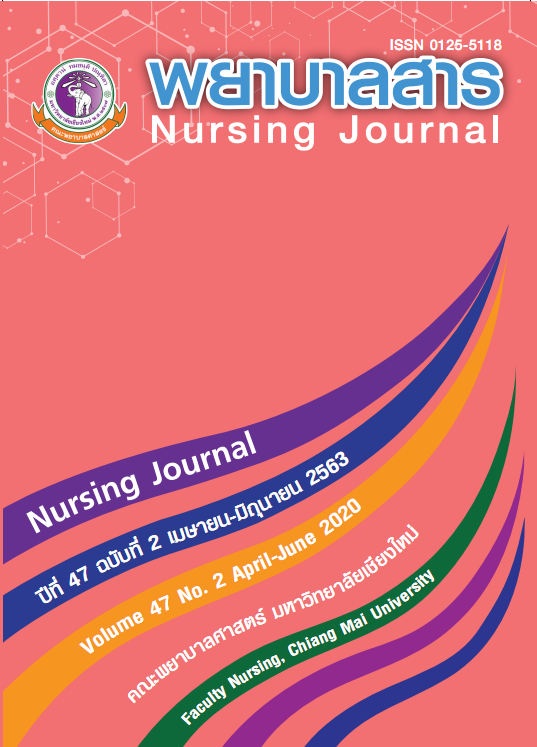Applying Lean Thinking to Improve Patient Discharge Process, Female Medical Ward 1, Buddhachinnaraj Phitsanulok Hospital
Keywords:
Applying lean concepts, Distribution process, Internal MedicineAbstract
Rapid patient discharge is a part of providing efficient and responsive service to the needs of the customer. The purpose of this study was to improve the patient discharge process in Female Medical Ward 1, Buddhachinnaraj Phitsanulok Hospital, by using the Lean Thinking Concept of Womack and Jones (2003). The sample included 32 personnel that are involved in the patient discharge process and discharge activities and the numbers of the activities in nursing service during July to September 2017. The research instruments included: 1) a table for describing the activities of the discharge process, 2) a form for value analysis of discharge activity, 3) a record form for time spent on discharge activity 4) the focus group interview guidelines regarding problems and recommendations. These research instruments were validated by three experts. The inter-rater reliability of two observers for the recorded time was 1.0. Data were analyzed using descriptive statistics
The results revealed that:
- The patient discharge process improvement applying Lean thinking in Female Medical Ward 1 consisted of five major activities and 15 minor activities which is a reduction from the original 20 minor activities for the process before improvement.
- The standard time of the improved patient discharge process applying Lean thinking in Female Medical Ward 1 was greatly reduced to 56.13 minutes from the original standard time of 247.00 minutes before improvement.
- The problems of applying Lean Thinking to improve discharge process in Female Medical Ward 1 include: 1) personnel who were familiar with the old routine discharge process 2) the usual high workload of the nurses leaves limited time to do some of the improved discharge activities 3) different understanding of personnel regarding the Lean Thinking. The recommendations included continuous supervision, supporting and assisting personnel, matching the staffing to the workload, and developing a plan to educate personnel about the concepts of Lean Thinking.
The results of this study revealed that the improvement of the patient discharge process using the Lean thinking can reduce the process and duration of the operation.
References
Buddhachinaraj Phitsatnulok Hospital Information Technology Center. (2016). Annual Report in Fiscal Year 2016. Phitsanulok: Buddhachinaraj Phitsatnulok Hospital. (In Thai)
Deeseentham, K. (2009). Lean Enterprise: Factors towards Excellent Organizations. Retrieved from http://www.thailandindustry.com (In Thai)
Female Medical Ward 1 Statistics. (2016). Fiscal Year 2016 Annual Report Record.Phitsanulok: Buddhachinaraj Phitsatnulok Hospital. (In Thai)
Hanucharurnkul, S. (2009). 1st Volume Medical Nursing (14th ed.). Bangkok: Department of Nursing, Faculty of Medicine, Ramathibodi Hospital Mahidol University. (In Thai)
Jirapattarasilp, K. (2010). Time Study. Retrieved from http://www.pteonline.org/img-lib/staff/file/komson_000822.pdf (In Thai)
Klomjit, P. (2014). Productivity Improvement: Principle and Practice. Bangkok: Se-ed Education. (In Thai)
Kumhang, A. (2015). Develoopment of a Patient Discharge Process in a Male Medical Ward 1,Nakornping Hospital, Chiang Mai Province (Independent Study, Chiangmai University). (In Thai)
Kunnasit, S., (2015). Development of an Admission Process for Traumatic Brain Injured Patients in a Surgical Ward, Pua Crown Prince Hospital, Nan Province (Independent Study, Chiangmai University). (In Thai)
Norkaew, W. (2010). Development of Model for Patient Discharge Management in Privat e Ward2, Maharaj Nakorn Chiang Mai Hospital Province (Independent Study, Chiangmai Universi -ty). (In Thai)
Panthiya, S. (2010). Development of a Patient Discharge Management Model in Sun-Neu rosurgical Intensive Care Unit, Maharaj Nakorn Chiang Mai Hospital (Independent Study, Chiangmai University). (In Thai)
Porpin, R. (2009). Development of Cesarean Section Preparation Management Process in the Operating Room, McCormick Hospital, Chiang Mai Province (Independent Study, Chiangmai University). (In Thai)
Rijiravanich, V. (2010). Work Study: Principle and Case Study (7 th ed.), Bangkok: Chulalongkorn University. (In Thai)
Senadesai, S., & Arpanantikul, M. (2009). Nursing Practice Manual. Bangkok: Chut thong. (In Thai)
Srisatidnarakul, B. (2007). Leadership and Strategic Management in Nursing Organization for the 21 st Century. Bangkok: Chulalongkorn University. (In Thai)
Supachutikul, A. (2009). Lean & seamless health care. Pathumthani: The Healthcare Accreditation Institute. (In Thai)
Tangsathajaroenporn, W., Kaewthummanukul, T., & Sripusanapan, A. (2012). Work Ability among Professional Nurses in a University Hospital and Related Factor s. Nursing Journal, 39 (4), 152-168. (In Thai)
Corrado, J., Topley, K., & Cracknell, A. (2015). Improving the efficacy of elderly patients’ hospita discharge through multi-professional safety briefings and behavioural change. BMJ Quality Improvement Reports, 4 (1), 1-3. doi:10.1136/bmjquality.u209431.w3871
Womack, J. P., & Jones, D. T. (2003). Lean thinking: Banish waste and create wealth in your corporation. New York: Simon & Schuster.
Downloads
Published
How to Cite
Issue
Section
License
บทความที่ได้รับการตีพิมพ์เป็นลิขสิทธิ์ของวารสารพยาบาลสาร
ข้อความที่ปรากฏในบทความแต่ละเรื่องในวารสารวิชาการเล่มนี้เป็นความคิดเห็นส่วนตัวของผู้เขียนแต่ละท่านไม่เกี่ยวข้องกับมหาวิทยาลัยเชียงใหม่ และคณาจารย์ท่านอื่นๆในมหาวิทยาลัยฯ แต่อย่างใด ความรับผิดชอบองค์ประกอบทั้งหมดของบทความแต่ละเรื่องเป็นของผู้เขียนแต่ละท่าน หากมีความผิดพลาดใด ๆ ผู้เขียนแต่ละท่านจะรับผิดชอบบทความของตนเองแต่ผู้เดียว






